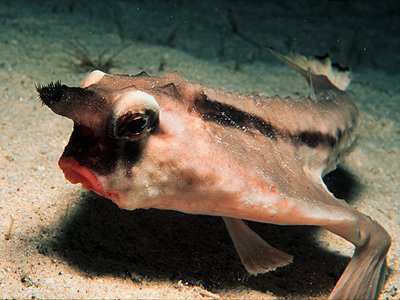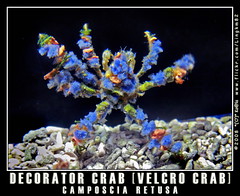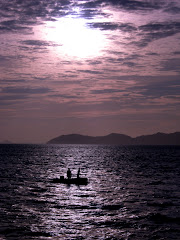So, as I've said, I'm getting to know the inhabitants off sunset beach really well. A young boy, Jason, who I was diving with today told me he wanted to see a puffer fish. I said that although it was difficult to predict what the Ocean would bring that day I had never seen a puffer off Sunset Beach. I think this little spiny puffer heard me:

He was hiding against some rocks the same color as him when I happened along. Apparently these guys like to swim slowly near to or rest on the bottom, blending with the background. I love puffer fish's eyes. They are all glassy and really look like they are looking deep into you. This guy was trying to hide. We looked at him for a little while and then left him to his business.

What cute little faces they have. Its those big eyes that make them look like they have sweet little personalities. I wonder what he was really thinking ('I wish these big scary divers would leave me alone to get on with feeling melancholy... if I stare really hard at her I bet she'll think I know what she is thinking'). Might I add that as well as spiney puffer this character is also known as a porcupinefish.
Some Interesting Info on the Porcupine Fish:
Porcupinefish Scientific Name: Diodon hystrix Porcupinefish suck up water to scare predators. The thick, leathery skin of porcupinefish is covered by scales that have been modified into spines. They are extended when the porcupinefish gulps down water to puff out and sticks a hungry predator.
Appearance
Shaped like a short baseball bat, the porcupinefish doesn’t seem like a fierce creature. Looking closer, it is found to be quite dangerous. The scales of this fish are modified into long spines, which generally lie flat against the body. When frightened, porcupinefish quickly gulps down lots of water. This makes the fish expand like a balloon—doubling and even tripling in size. As the porcupinefish puffs up, the spines on the skin stick straight out, making this fish even harder to eat. After the frightened predator swims away, the porcupinefish lets loose all the water inside its body, getting back to its normal shape and size.
This fish can be up to 3 feet (1 m) long, which would be quite a display after puffing out its entire body into a ball shape.
Habitat
Porcupinefish live in the caves and holes of lagoon and seaward reefs at depths of 7 to 167 feet (2 to 50 m). Generally they can be found either resting in a reef hideaway or swimming out in the open over the reef.
Juveniles and occasionally adults may live in the open ocean floating around within the safety of Sarassum weeds, which is a leafy golden brown algae that floats freely throughout the ocean with small air bubbles or bladders. Catching a free ride inside these weeds allows the porcupinefish to be found in all the tropical oceans.
Range
Porcupinefish live in the warm parts of all the warm Oceans.
Diet
At night, the porcupinefish searches for hard-shelled sea urchins, snails and crabs. “Diodontidae", the Family name of this animal, means “two-toothed". This refers to the hard beak-like jaw that the porcupinefish uses to crush its crunchy prey. Sometimes this fish will also eat sea jellies.
Reproduction
At sunrise or sunset, porcupinefish pelagic spawn, which means they mate in an area where the fertilized eggs will be taken away on the currents to drift into the open ocean. Pairs may spawn together, or a group of males will spawn with a single female. After the eggs hatch, the larvae float in the open ocean near the surface. When the small fish grows to a certain size, it will swim down and become a member of a coral reef.
Threats and Management
These fish are sometimes sold to souvenir shops, where the porcupine fish are lacquered in their puffed up state. Otherwise, they are not highly sought after because their organs are poisonous. The poison in the fish actually comes from a type of toxic algae that the porcupinefish eats.
Skilled Japanese chefs prepare porcupinefish and boxfish, which is called fuga, in a way that retrieve the meat and almost all the poisonous parts are cut out. A slight amount of poisonous meat is left to be served with the safe portion. The diner feels somewhat woozy after eating the fuga. Prepared in this way, these fish are considered a delicacy. On occasion, a person eating the fuga dies.
While porcupinefish are taken for souvenirs and occasionally to eat, there hasn’t been an overabundance of them taken from the oceans. Their population remains stable.
Did You Know?
As another defense mechanism, high levels of poison are concentrated in the porcupinefish’s gonads and liver. Most predators will remember getting sick from eating a porcupinefish and won’t try it again.
Few animals will eat porcupinefish. Tiger sharks, which are known as the garbage cans of the sea because they eat just about anything, will eat adult porcupinefish. Juveniles are eaten by large billfish like dolphinfish and tuna.










 Yesterday I went cave diving with German Yanez who is a cave instructor in Cozumel. We dove in two very different caves.
Yesterday I went cave diving with German Yanez who is a cave instructor in Cozumel. We dove in two very different caves.

